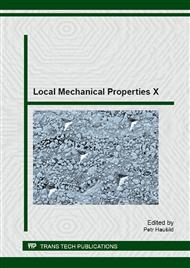p.73
p.77
p.81
p.87
p.91
p.95
p.99
p.103
p.107
Effect of Grit-Blasting on Residual Stress Field
Abstract:
The effect of grit-blasting on the development of residual stress field during the surface treatment of the cold rolled mild steel was characterized by means of neutron diffraction, nanohardness measurement and electron back-scatter diffraction. The neutron diffraction revealed strong residual compressive stress with the maximum value (about-100 MPa) situated just under the sample surface of the grit-blasted sample. The deformation profiles obtained by the nanoindentation and electron back-scatter diffraction (band slope signal) revealed the strain hardening after grit blasting up to depth of approximately 100 μm.
Info:
Periodical:
Pages:
91-94
Citation:
Online since:
March 2014
Authors:
Price:
Сopyright:
© 2014 Trans Tech Publications Ltd. All Rights Reserved
Share:
Citation:


